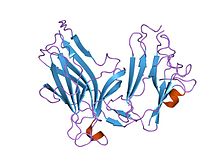Ephrin
| Ephrin | |||||||||
|---|---|---|---|---|---|---|---|---|---|

structural and biophysical characterization of the ephb4-ephrinb2 protein protein interaction and receptor specificity.
|
|||||||||
| Identifiers | |||||||||
| Symbol | Ephrin | ||||||||
| Pfam | PF00812 | ||||||||
| Pfam clan | CL0026 | ||||||||
| InterPro | IPR001799 | ||||||||
| PROSITE | PDOC01003 | ||||||||
| SCOP | 1kgy | ||||||||
| SUPERFAMILY | 1kgy | ||||||||
| CDD | cd02675 | ||||||||
|
|||||||||
| Available protein structures: | |
|---|---|
| Pfam | structures |
| PDB | RCSB PDB; PDBe; PDBj |
| PDBsum | structure summary |
Ephrins (also known as ephrin ligands or Eph family receptor interacting proteins) are a family of proteins that serve as the ligands of the eph receptor. Eph receptors in turn compose the largest known subfamily of receptor protein-tyrosine kinases (RTKs).
Since ephrin ligands (ephrins) and Eph receptors (Ephs) are both membrane-bound proteins, binding and activation of Eph/ephrin intracellular signaling pathways can only occur via direct cell-cell interaction. Eph/ephrin signaling regulates a variety of biological processes during embryonic development including the guidance of axon growth cones, formation of tissue boundaries,cell migration, and segmentation. Additionally, Eph/ephrin signaling has recently been identified to play a critical role in the maintenance of several processes during adulthood including long-term potentiation,angiogenesis, and stem cell differentiation.
Ephrin ligands are divided into two subclasses of ephrin-A and ephrin-B based on their structure and linkage to the cell membrane. Ephrin-As are anchored to the membrane by a glycosylphosphatidylinositol (GPI) linkage and lack a cytoplasmic domain while ephrin-Bs are attached to the membrane by a single transmembrane domain that contains a short cytoplasmic PDZ-binding motif. The genes that encode the ephrin-A and ephrin-B proteins are designated as EFNA and EFNB respectively. Eph receptors in turn are classified as either EphAs or EphBs based on their binding affinity for either the ephrin-A or ephrin-B ligands.
Of the eight ephrins that have been identified in humans there are five known ephrin-A ligands (ephrin-A1-5) that interact with nine EphAs (EphA1-8 and EphA10) and three ephrin-B ligands (ephrin-B1-3) that interact with five EphBs (EphB1-4 and EphB6). Ephs of a particular subclass demonstrate an ability to bind with high affinity to all ephrins of the corresponding subclass, but in general have little to no cross-binding to ephrins of the opposing subclass. However, there are a few exceptions to this intrasubclass binding specificity as it has recently been shown that ephrin-B3 is able bind to and activate EPH receptor A4 and ephrin-A5 can bind to and activate Eph receptor B2. EphAs/ephrin-As typically bind with high affinity, which can partially be attributed to the fact that ephrinAs interact with EphAs by a "lock-and-key" mechanism that requires little conformational change of the EphAs upon ligand binding. In contrast EphBs typically bind with lower affinity than EphAs/ephring-As since they utilize an "induced fit" mechanism that requires a greater conformational change of EphBs to bind ephrin-Bs.
...
Wikipedia
